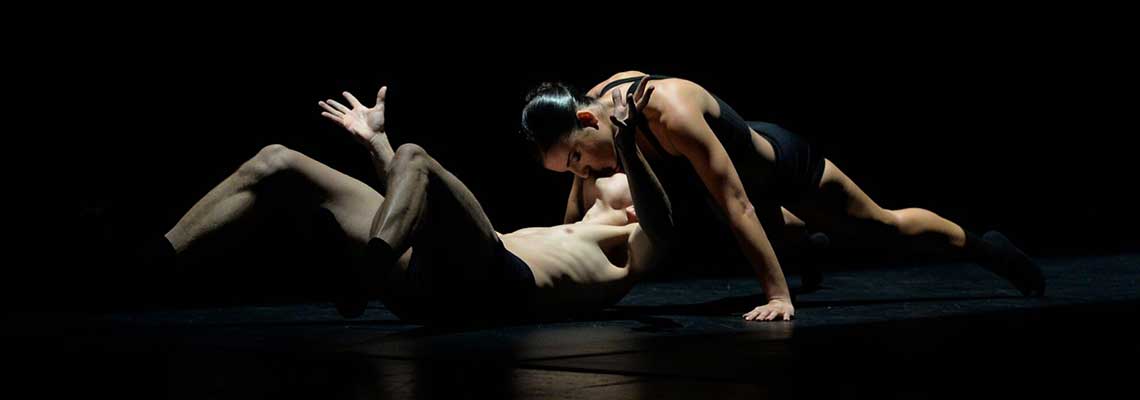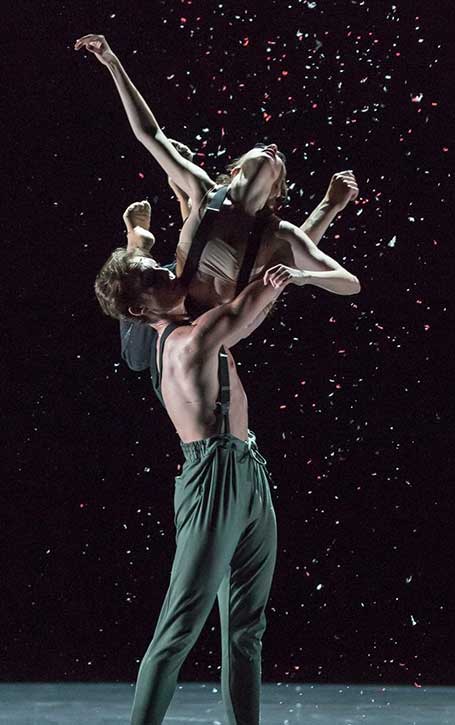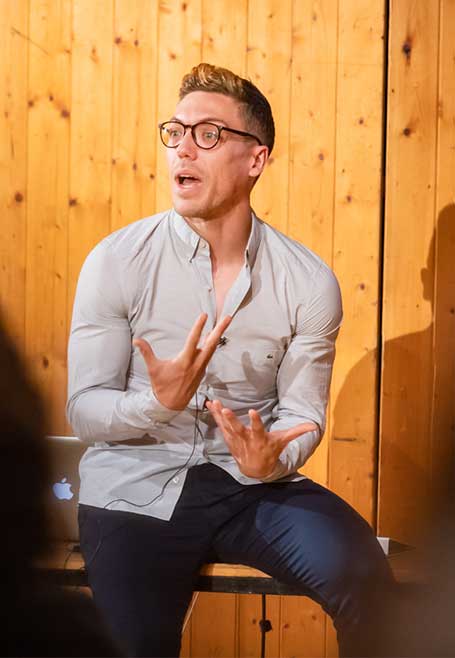
The many faces of Jorge García Perez
On this occasion we would like to invite you to an interview with choreographer and dancer Jorge Garcia Perez. This is a truly special guest for us, since we have been part of Jorge’s journey as dancer and choreographer since its beginnings. As matter of fact, our manager Cintia Decastelli, has shared stages with him on several occasions, not only at the Zurich’s Opera House and Basel Theatre, but many abroad (you may find an interview of them both regarding a dancing gala in London).
We would love to talk about his choreographic style, his incredible creations, the international awards and recognition received or his undeniable talent as a dancer; but today we must be satisfied with his enriching experiences as an artist and individual. Anyway, we not must put the anecdotes and introductions aside, so Jorge can tell us a little more about his past, present and future.
AS A DANCER
You were very young when you arrived in Switzerland and your career as a dancer was developed almost entirely between the Zurich Opera and Basel Theatre. Important roles were given to you from Heinz Spörli to Richard Wherlock, Heinz hiring you for his classical company, after watching you dance to a contemporary piece.
Yes. I came to Switzerland joining the Züricher Ballett when I was only 17 years old and from the beginning I was lucky to be able to grow and improve as a dancer having to defend and develop important roles that were given or made for me since I was that young. I was a very mature dancer even being that young and I always gave security to those choreographers that wanted me to perform their work and creations. I think also my versatility was a great point to inspire them to create with me.
When and where did Mr. Spörli saw you and why do you think you made such an impression in a classical director by performing as a contemporary dancer?
The first time Heinz Spoerli saw me was at Premio Roma, a competition for professional dancers. I was at the time 17 years old and he was a member of the jury in this ballet competition. The first step on the competition was performing the contemporary variations and I can still clearly remember how he came to me after performing my first variation, a solo from the wonderful piece 27’52” by Jiri Kylian that afterwards became part of my life performing it in both Zürcher Ballett and Ballett Theater Basel during my dance career. Heinz came to me and said: I want you in my company. You are a very talented dancer and I can already see through that performance your versatility and both classical and modern technic. No matter what happens in the competition and if you win a prize or not, I want you to join Zurich Ballet in the next month if you agree. That was a dream. For me that was already a win and to think of going into that amazing ballet company in already a month time was an incredible feeling of achievement. It also happened that I won the Premio Roma after a hard week of performing five different variations, classical and modern choreographies and my next steps and plans completely changed. I was going through Italy after the competition to audition for different companies but after Spoerli’s offer and winning that Prize I changed all my plans and I booked a direct flight home to spend the last month with my family before moving abroad of my country to live in Switzerland.
When did you became part of Basel’s Theater company and what made you stay for so long, since most dancers don’t establish lasting relationships with a single company?
I joined Ballett Theater Basel in season 2008/2009. This year is my 10th season with this beautiful company. Another big step for me, moving from a more classical company into a more modern one but a change of style I wanted to make. I always liked versatility in dance and that was a way for me to step up and keep growing as an artist.
I didn’t know how long I will stay in Basel but to be offered a job in one of the best modern ballet companies in the world was again a dream and very close to where I was living before. A dream feeling that is still happening nowadays when I go to work. After ten years in the company it still feels like the first day I arrived and met Richard Wherlock, a wonderful not only director but a person that makes you feel loved and home.
I still remember like yesterday my first time in Basel, how I auditioned in Ballett Theater Basel and met one of the ballet masters of the company, Cristiana Sciabordi who was leading the company audition. What an incredible and beautiful dancer, she was teaching us the steps of the choreography to learn and I was stunned by her. I just wanted to join this place so bad to be an amazing and special dancer too.
I admire, love and respect this beautiful place with all the people that makes it alive. This is what made me establish myself here and stay so long. I am so thankful to Richard that made possible for me to to be where I am today.
AS A CHOREOGRAPHER
From early on, you dwelled in choreographic work, and by 2014 you had reached the finals for the prestigious Hannover International Competition for young choreographers. Even with such credentials, today we would like to talk about Dancelab, which it’s celebrating its ninth edition this year.
For those unaware of this initiative, masterminded by Richard Wherlock under the name of Dancelab, it is aimed towards the dancers from Theatre Basel’s own company, with the goal of encouraging choreographic development amongst them. This is a great opportunity to enable the dancers to do choreographic work once a year with artists from within the company, alongside the vast infrastructure of Basel’s Theater with its technical bodies, such as scenography, lighting, costumes, amongst others.
Having attended multiple times to these events, both as choreographer and dancer, you started contributing in the choreographic work of your colleagues.
Dancelab is just an incredible platform that in my point of view should be part of every single dance company in the world and in every single dancer’s career experience. It is just an amazing way of growing as an artist both being a dancer as a part in your colleagues pieces or creating yourself your own work.
As a dancer, to push yourself into different dance styles and learn from your colleagues qualities. It is quite grateful to make them proud of their own work and It makes you get closer, understand and connect with their way of being.
As a choreographer, it gives you the space to explore and experience and also to get to know yourself better having to create a product using all your possible resources. I think it is the best way for a dancer that wants to become a choreographer to have this space to explore and to make mistakes without pressure. Without being scare to be likeable or not but using the space to create and develop your own choreography. Having to learn from not only making steps but all what comes around it, ideas, lighting, costumes, stage design, all the things around that makes the piece with the dancers timing and rehearsal schedule. It is all more complex than some people think and it is quite challenging to put everything together.
Also for those who are not interested to become a choreographer to learn and to push your limits. I think everyone should once try to choreograph something to enrich themselves and know yourself not only as a dancer but as a person.
That is why I think this platform is great for every artist. We learn from our colleagues and also what means to put on a show and everything around that a choreographer has to always have in mind for an evening production show.
Jorge García Pérez rehearsing at Theater Basel
FOTO Uta Grütter
Amyra Badro / Matei Holeleu
Ballettschule Theater Basel
Golden Insomnia choreographed by Jorge García Pérez
FOTO Gregory Batardon
How was your experience during those times and what do you value most about this initiative? Do you consider that it motivated you in your beginnings as a choreographer and strengthened your choreographic career?
It has definitely push me into becoming a choreographer. My first experience was in 2011, my first dancelab which was a choreographic competition and each of the dancers had a music composer composing the music for the choreography we made. That was an amazing experience working with the amazing composer Teresa Carrasco. It was a challenging process because to create a piece not only with dance steps but creating music too, was not easy. But our final product was the winner of the Jugendfoerderpreis Sperber Des-Kollegiums. The prize was given by jazz legend George Gruntz and here I already started to realise that maybe this was a good direction for me and that i had some talent for it. Also I loved to choreograph and loved to be so focused in creating, made me feel like a real artist.
After this experience I kept on creating different choreographic works and that has given me some rewarding experiences being finalist and winning prizes in many international choreographic competitions like Hannover International Choreographic Competition in Germany, Cross Connection International Choreographic Competition in Denmark and Burgos-New York International Choreographic Competition in Spain.
Also all those experiences have brought me to be of interest for different professional ballet companies and professional ballet schools and in this past years I have already created work for Staatstheater Mainz, Delattre Dance Company, Konzert Theater Bern Ballet, Covent Garden Dance Company, Bejart Ballet Lausanne, Shanghai Ballet, San Francisco Ballet, Balletschule des Theater Basel…
So I can say Dancelab started as a platform that has made me today a not only a dancer but a choreographer in develop, I have still a lot to learn but a lot of passion to give through my choreography.
AS A ARTISTIC DIRECTOR
Carta Blanca Dance: Carta Blanca Dance was conceived in 2016, as a freelancing company that Jorge built together with his friend Permi Jhooti upon the success and great personal achievements obtained in his choreographic projects.
Why is it called Carta Blanca Dance and what does the project mean to you? What tools and obstacles did you encounter when starting the company? Switzerland stands out for its aiding and support of artistic endeavors, by your experience, do you this is an accurate portrait of the current state of cultural affairs?
Carta Blanca Dance combines the worlds of dance, music, art, science and technology and was created with the aim of giving a platform to young artist where they can create without limits using all art forms needed for their performance. That is why we called it Carta Blanca Dance, because we give total freedom to those artists for experimenting, experience and express but offering them all our possible support for them to freely explore.
Switzerland has lots of supports for artist and freelance artists to be able to work and of course at the beginning was not easy for me to get the support from those institutions. I am still seeing as a dancer working for a big theater without needing anything else for a living. What was difficult to prove is all my free time work that I was putting besides my job to improve the quality of art and dance in the city, working together with freelance artist to collaborate, exchange experience and work, learn from each other and make arts bigger and better if possible.
Jorge García Perez, On Commitment
YouTube
Creative Mornings
Nowadays I think people know Carta Blanca Dance, all the different platforms we have to bring different audience, from younger to older into knowing more dance and arts which can create to all of performing arts a future audience. We fight for artists to be alive and have support to keep creating and we are thankful for all those institutions that support arts in Switzerland.
I would say Carta Blanca Dance is a place to experience with high quality artist and a place to show an audience to know and love arts.
To wrap things up, we would like to know more about your plans for the future and if you may, share some advice for those readers who are just starting their career.
I cannot really know what my future brings but what I can surely say is that I will be bringing some more dancing with Ballett Theater Basel and more choreography for Carta Blanca Dance and other ballet companies.
It is soon planned for me going to Shanghai to create two new short works for the company there. I am excited in getting soon to know the beautiful dancers there.
Also I will be performing in the next programs of the Ballett Theater Basel which are going to be a mix program with two new creations by guest choreographers and also a full evening program with the new creation of Comedy of Errors by Richard Wherlock.
Do you feel that you achieved true harmony between dancing and choreography, and do you think you are on a strong path with your current balance between them, or do you see yourself flowing towards new directions where choreography plays a decisive role in your decisions?
I love dancing and choreographing and I think they are both very compatible into making both better by understanding your body qualities better. It is true that I see myself in a future working with different dancers and different ballet companies around the globe, developing my own choreographic work I love getting to know different type of dancers that I can get inspired by and create with them. If in a future I am able to dedicate all my time into choreography with the time to experiment and explore I think I will be able to deliver an even better work. But I am in a good direction to it.
What is the meaning of dance to you, and what would you say to inspire those who are starting out or still developing their skills?
My advice is to just be honest and true to yourself. Whatever direction you might take in dancing, choreographing, directing or any other direction, do what you really love being honest to yourself. Find your quality which is what makes you special, explore it, improve it and then enjoy it. keep yourself busy with things you like will make you grow and keep you positive.
14 QUESTIONS + 14 ANWERS
TO KNOW GARCÍA PÉREZ
Coffee or tea? Coffee with milk.
Coffee or tea? Coffee.
Do you prefer day or night? Day for pleasure, night for inspiration.
Sweet or sour? Sweet.
Comedies or drama? Drama.
Do you usually judge a book by its cover? Sometimes.
House or apartment? Apartment.
Who inspires you the most? Every single person that isn’t scared to make mistakes to learn and grow into a better human.
What instrument would you like to play? Cello.
Which sense you couldn’t live without? Hearing. Because sound is vibration and that brings feeling into my soul. I get inspired by sound, I create and move by this sense.
Perfect music? Anything Ólafur Arnalds creates is just perfection.
If you could travel in time, would you go to the past or the future? I would travel to the future. I always like to discover and learn new things.
What other language would you like to speak? Sign language, because if I could also use just my body movement to express and talk to other people.
Do you collect anything? Passion, from all the people I work with. I keep it in my heart.
Are you superstitious? Not really.
Main Photograph
Marina Sánchez Garrigós / Max Zachrisson
Distorted Season
Choreographed by Jorge García Pérez
Teatro Principal de Zaragoza
FOTO Uta Grütter








